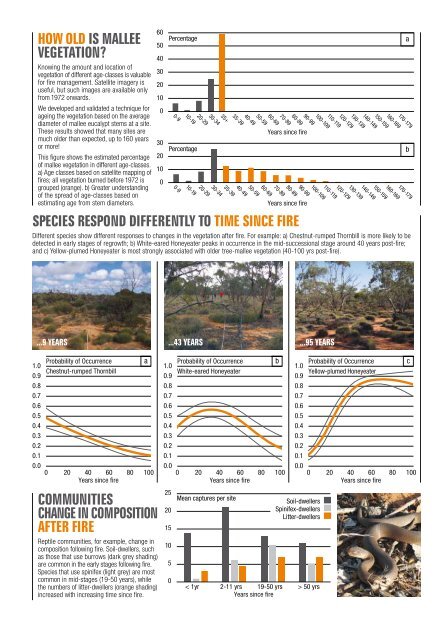Fire and Wildlife in the Mallee - Eyre Peninsula Natural Resources ...
Fire and Wildlife in the Mallee - Eyre Peninsula Natural Resources ...
Fire and Wildlife in the Mallee - Eyre Peninsula Natural Resources ...
- No tags were found...
Create successful ePaper yourself
Turn your PDF publications into a flip-book with our unique Google optimized e-Paper software.
How old is mallee<br />
vegetation<br />
Know<strong>in</strong>g <strong>the</strong> amount <strong>and</strong> location of<br />
vegetation of different age-classes is valuable<br />
for fire management. Satellite imagery is<br />
useful, but such images are available only<br />
from 1972 onwards.<br />
We developed <strong>and</strong> validated a technique for<br />
age<strong>in</strong>g <strong>the</strong> vegetation based on <strong>the</strong> average<br />
diameter of mallee eucalypt stems at a site.<br />
These results showed that many sites are<br />
much older than expected, up to 160 years<br />
or more!<br />
This figure shows <strong>the</strong> estimated percentage<br />
of mallee vegetation <strong>in</strong> different age-classes.<br />
a) Age classes based on satellite mapp<strong>in</strong>g of<br />
fires; all vegetation burned before 1972 is<br />
grouped (orange). b) Greater underst<strong>and</strong><strong>in</strong>g<br />
of <strong>the</strong> spread of age-classes based on<br />
estimat<strong>in</strong>g age from stem diameters.<br />
60<br />
Percentage<br />
50<br />
40<br />
30<br />
20<br />
10<br />
0<br />
30<br />
20<br />
10<br />
0<br />
35+<br />
30-34<br />
20-29<br />
10-19<br />
0-9<br />
Species respond differently to time s<strong>in</strong>ce fire<br />
Different species show different responses to changes <strong>in</strong> <strong>the</strong> vegetation after fire. For example: a) Chestnut-rumped Thornbill is more likely to be<br />
detected <strong>in</strong> early stages of regrowth; b) White-eared Honeyeater peaks <strong>in</strong> occurrence <strong>in</strong> <strong>the</strong> mid-successional stage around 40 years post-fire;<br />
<strong>and</strong> c) Yellow-plumed Honeyeater is most strongly associated with older tree-mallee vegetation (40-100 yrs post-fire).<br />
35-39<br />
80-89<br />
70-89<br />
60-69<br />
50-59<br />
40-49<br />
35-39<br />
30-34<br />
20-29<br />
10-19<br />
0-9<br />
Percentage<br />
80-89<br />
70-89<br />
60-69<br />
50-59<br />
40-49<br />
Years s<strong>in</strong>ce fire<br />
Years s<strong>in</strong>ce fire<br />
160-169<br />
150-159<br />
140-149<br />
130-139<br />
120-129<br />
110-119<br />
100-109<br />
90-99<br />
160-169<br />
150-159<br />
140-149<br />
130-139<br />
120-129<br />
110-119<br />
100-109<br />
90-99<br />
a<br />
170-179<br />
b<br />
170-179<br />
...9 years ...43 years ...95 years<br />
Probability of Occurrence a<br />
1.0<br />
Chestnut-rumped Thornbill<br />
0.9<br />
0.8<br />
0.7<br />
0.6<br />
0.5<br />
0.4<br />
0.3<br />
0.2<br />
0.1<br />
0.0<br />
0 20 40 60 80 100<br />
Probability of Occurrence b<br />
1.0<br />
White-eared Honeyeater<br />
0.9<br />
0.8<br />
0.7<br />
0.6<br />
0.5<br />
0.4<br />
0.3<br />
0.2<br />
0.1<br />
0.0<br />
0 20 40 60 80 100<br />
Probability of Occurrence c<br />
1.0<br />
Yellow-plumed Honeyeater<br />
0.9<br />
0.8<br />
0.7<br />
0.6<br />
0.5<br />
0.4<br />
0.3<br />
0.2<br />
0.1<br />
0.0<br />
0 20 40 60 80 100<br />
Years s<strong>in</strong>ce fire<br />
Communities<br />
change <strong>in</strong> composition<br />
after fire<br />
Reptile communities, for example, change <strong>in</strong><br />
composition follow<strong>in</strong>g fire. Soil-dwellers, such<br />
as those that use burrows (dark grey shad<strong>in</strong>g)<br />
are common <strong>in</strong> <strong>the</strong> early stages follow<strong>in</strong>g fire.<br />
Species that use sp<strong>in</strong>ifex (light grey) are most<br />
common <strong>in</strong> mid-stages (19-50 years), while<br />
<strong>the</strong> numbers of litter-dwellers (orange shad<strong>in</strong>g)<br />
<strong>in</strong>creased with <strong>in</strong>creas<strong>in</strong>g time s<strong>in</strong>ce fire.<br />
25<br />
20<br />
15<br />
10<br />
5<br />
0<br />
< 1yr<br />
Years s<strong>in</strong>ce fire<br />
Mean captures per site<br />
Soil-dwellers<br />
Sp<strong>in</strong>ifex-dwellers<br />
Litter-dwellers<br />
2-11 yrs 19-50 yrs > 50 yrs<br />
Years s<strong>in</strong>ce fire<br />
Years s<strong>in</strong>ce fire
















